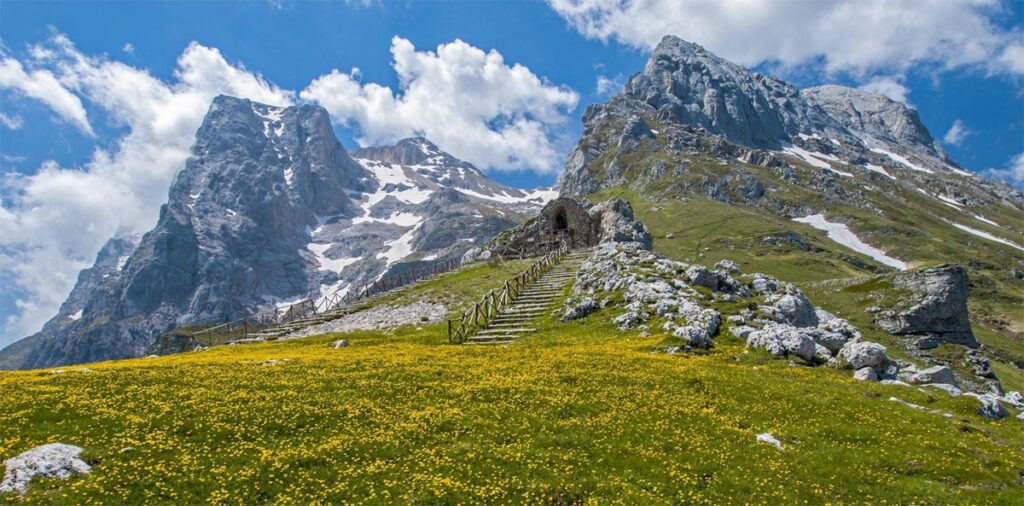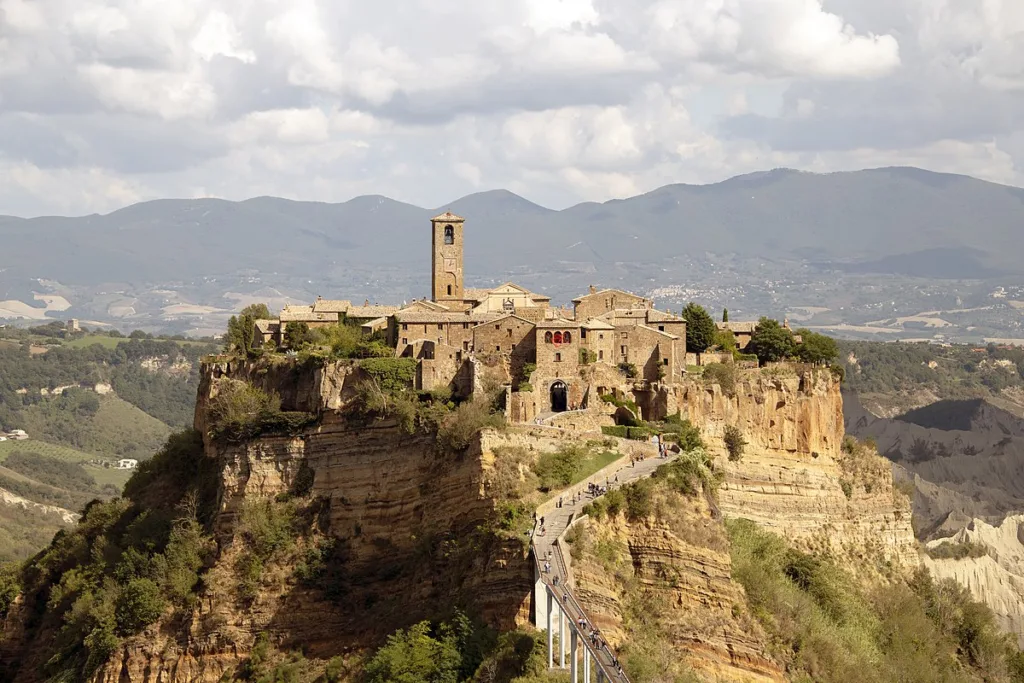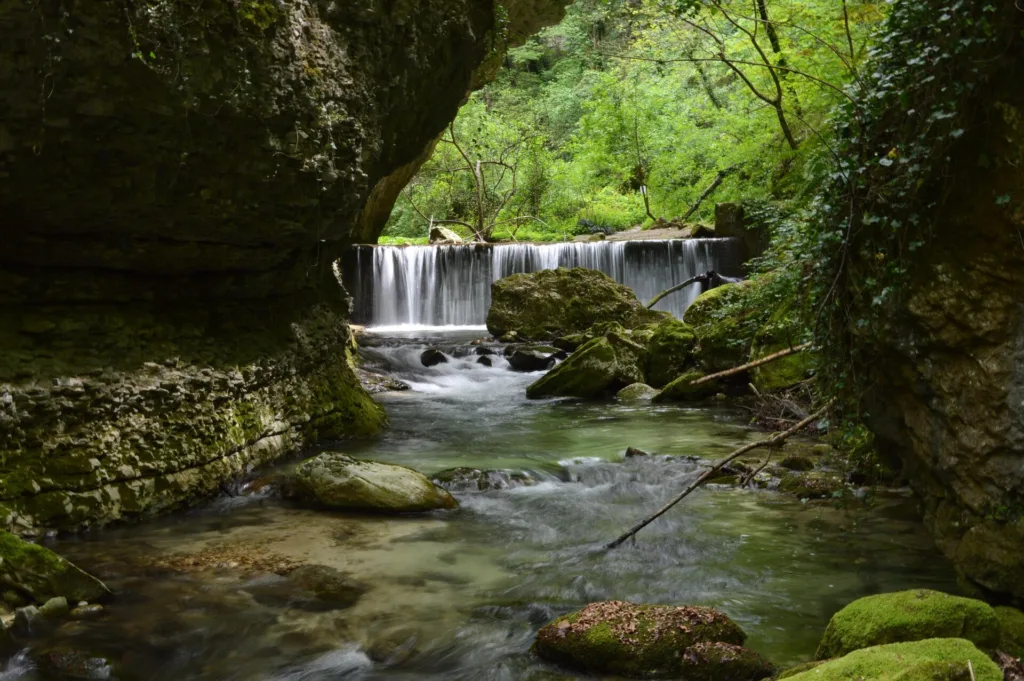Gran Sasso and Monti della Laga National Park is one of Italy’s most dramatic landscapes. Covering over 1,400 square kilometers across Abruzzo, Lazio, and Marche, it combines rugged alpine scenery, medieval castles, waterfalls, lakes, and charming villages. Here you’ll find Corno Grande, the highest Apennine peak, the vast Campo Imperatore plateau, and rich wildlife in wild forests.

Jump to
TogglePeaks, Plateaus, and Glaciers
The Gran Sasso massif dominates the park with Corno Grande standing at 2,912 meters. On its slopes lies the Calderone glacier, once the southernmost glacier in Europe, now a shrinking glacieret. Hiking here offers sweeping views and alpine conditions rare in central Italy.
The Campo Imperatore plateau, nicknamed “Little Tibet,” stretches for kilometers under vast skies. It’s accessible by the Gran Sasso cable car from Fonte Cerreto or by road from Assergi. At the top stands the historic Campo Imperatore hotel and the Gran Sasso observatory, where science and history meet.
Hiking Adventures
Gran Sasso and Monti della Laga National Park offers countless trails for all levels. Organize your hikes by difficulty or interest:
Easier walks
Rocca Calascio – Short ridge trails to the fortress with panoramic views.
Lago Pietranzoni – A peaceful stroll to the reflective lake near Campo Imperatore.
Moderate hikes
Monte Camicia – Breathtaking “balcony” views over the plains and Adriatic coast.
Gole del Salinello – Dramatic canyons cut through limestone cliffs.
Challenging routes
Prati di Tivo and La Madonnina gondola – From the Teramo side, take the lift to 2,007 meters and hike toward Rifugio Franchetti.
Rifugio Franchetti – A classic alpine hut that serves as a base for Corno Grande ascents.
Cascata della Morricana – A rewarding trek to one of the Monti della Laga’s most beautiful waterfalls.
Lakes and Rivers
Water defines the park’s character. Lake Campotosto, the largest artificial lake in Abruzzo, is framed by mountain ridges and attracts windsurfers, anglers, and photographers. In spring and summer, wildflowers carpet its shores.
On the southern side, the Tirino River is renowned for its crystal-clear waters. Kayaking here is a tranquil way to enjoy nature, passing through willow groves and reed beds.
Villages of Stone and Tradition
The park is dotted with timeless villages:
Santo Stefano di Sessanio – A medieval town known for lentils, slow-food traditions, and boutique stays in restored stone houses.
Castel del Monte (Abruzzo) – Celebrated for transhumance culture and sweeping views of Campo Imperatore.
Calascio – Home to Rocca Calascio fortress, one of Italy’s most photogenic castles.
Castelli – Famous for maiolica pottery and the decorated ceiling of San Donato church.
Each village offers hospitality, traditional food, and cultural heritage, making them ideal bases for exploring the park.
Where to Stay
Accommodation options include:
Mountain stays
Campo Imperatore Hotel – Historic alpine-style hotel on the plateau, with direct access to trails and ski slopes.
Rifugio Franchetti – A mountain hut offering simple rooms, hearty meals, and an unforgettable alpine atmosphere.
Village stays
Santo Stefano di Sessanio – Boutique hotels in restored stone houses blending medieval charm with modern comfort.
Castel del Monte and Calascio – Guesthouses and agriturismi near Rocca Calascio.
Castelli – Family-run inns and B&Bs with easy access to Monte Camicia trails.
City stays
Wherever you stay, expect warm Abruzzese hospitality and proximity to hikes, skiing, and cultural highlights.
Wildlife and Forests
The park shelters rich biodiversity. Apennine chamois thrive on cliffs, wolves roam forests, and golden eagles soar overhead. In Monti della Laga, sandstone peaks capture rainfall, feeding waterfalls and vast beech woods.
Culture and Cuisine
Food is central to the experience. On Campo Imperatore, enjoy arrosticini, grilled lamb skewers served in refuges. In Santo Stefano, taste the celebrated lentils, a Slow Food delicacy. Castelli ceramics bring art into daily life, with workshops still producing colorful pieces. Festivals combine traditions with music, food, and folklore.
Practical Travel Tips
Access: Gateways include L’Aquila, Teramo, and Pescara. Rome is 1.5 hours by car via the A24.
Best time to visit: Spring to autumn for hiking, summer for festivals, winter for skiing.
Transport: Roads reach most villages. Note summer restrictions near Rocca Calascio, where shuttles may replace cars.
Rules: Camping outside official areas is prohibited. Drone use requires permits. Weather changes quickly—pack accordingly.
Movies and Legends
Gran Sasso has inspired filmmakers for decades. Rocca Calascio appeared in Ladyhawke and The Name of the Rose. The Campo Imperatore hotel is linked to Mussolini’s wartime rescue. Myths, legends, and history add intrigue to every tower and alpine meadow.
FAQs
Is Rocca Calascio free?
Yes, entrance is free. Access may require a shuttle on summer weekends.
Is the Gran Sasso cable car open?
It operates seasonally but is subject to intermittent closures for maintenance. Always check the latest status before visiting.
Which hike offers the easiest views?
Rocca Calascio and Monte Camicia’s balcony trails are manageable with stunning panoramas.
Can I camp in the park?
No wild camping is allowed. Use official campsites or mountain huts.
Where can I see waterfalls?
Visit Monti della Laga for Cascata della Morricana and other scenic falls.
Conclusion
Gran Sasso and Monti della Laga National Park is a land of peaks, plateaus, and medieval villages. From alpine hikes to kayaking, from chamois sightings to arrosticini feasts, it offers an authentic mix of nature and culture. Whether you climb Corno Grande, stroll through Santo Stefano, or gaze at Rocca Calascio, this park captures the essence of Abruzzo’s wild heart. Plan your journey and discover one of Italy’s most unforgettable destinations.
Disclosure: This page may contain affiliate links. This means that we get a small commission from any purchase you make, at no additional cost to you!

